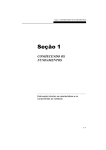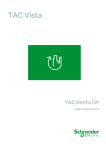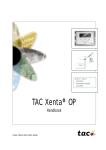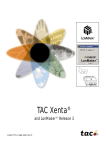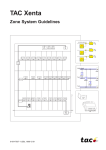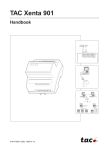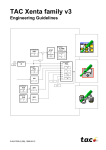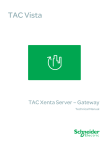Download Schneider Electric TAC Xenta 527-NPR Product manual
Transcript
TAC Vista TAC Pangaea WorkStation TAC Xenta 527-NPR Product Manual TAC Vista TAC Xenta 527-NPR Product Manual Copyright © 2007-2010 Schneider Electric Buildings AB. All rights reserved. This document, as well as the product it refers to, is only intended for licensed users. Schneider Electric Buildings AB owns the copyright of this document and reserves the right to make changes, additions or deletions. Schneider Electric Buildings AB assumes no responsibility for possible mistakes or errors that might appear in this document. Do not use the product for other purposes than those indicated in this document. Only licensed users of the product and the document are permitted to use the document or any information therein. Distribution, disclosure, copying, storing or use of the product, the information or the illustrations in the document on the part of non-licensed users, in electronic or mechanical form, as a recording or by other means, including photo copying or information storage and retrieval systems, without the express written permission of Schneider Electric Buildings AB, will be regarded as a violation of copyright laws and is strictly prohibited. Trademarks and registered trademarks are the property of their respective owners. TAC Xenta 527-NPR, Product Manual Contents Contents INTRODUCTION 1 About this Manual 1.1 1.2 1.3 1.4 1.5 2 Structure ..................................................................................................................... Typographic Conventions .......................................................................................... Prerequisites ............................................................................................................... How to Use this Book ................................................................................................ Related Documents .................................................................................................... 9 9 10 10 11 11 About TAC Xenta 527-NPR 13 2.1 2.2 13 14 TAC Xenta 527-NPR ................................................................................................. Communication Ports................................................................................................. GETTING STARTED 3 Commissioning the TAC Xenta 527-NPR 17 4 Connecting the TAC Xenta 527-NPR to Your Network 19 4.1 4.1.1 4.2 4.3 4.4 20 20 21 22 23 5 TAC Xenta 527-NPR Communication Ports ............................................................. Changing the HTTP and HTTPS Communication Port Settings ............................... Choosing a Location for the TAC Xenta 527-NPR ................................................... Connecting the TAC Xenta 527-NPR to an I/NET Controller LAN ......................... Using a Direct Connection to I/NET.......................................................................... Setting Up I/NET Communications 25 5.1 5.1.1 5.1.2 25 25 28 Defining I/NET Communication Parameters............................................................. From a Console Window ........................................................................................... From a Web Browser ................................................................................................. REFERENCE 6 7 I/NET Web Shell Commands 33 6.1 6.2 33 34 Submitting I/NET Web Shell Commands.................................................................. Summary of Commands............................................................................................. SNMP Polling of I/NET System Variables 35 7.1 7.2 36 37 SNMP System Variables............................................................................................ Monitoring System Variables from an NMS Application ......................................... Index Schneider Electric Buildings AB, Mar 2010 04-00053-01-en 39 5 (42) Contents 6 (42) TAC Xenta 527-NPR, Product Manual Schneider Electric Buildings AB, Mar 2010 04-00053-01-en INTRODUCTION 1 About this Manual 2 About TAC Xenta 527-NPR TAC Xenta 527-NPR, Product Manual 1 1 About this Manual About this Manual This manual describes the configuration and operation of TAC’s Xenta 527-NPR. For information on supporting products, please refer to the manual for the product in question. The Xenta 527-NPR is a feature-enhanced version of the I/NET Net Plus Router. Notes 1.1 • We are continuously improving and correcting our documentation. This manual may have been updated. • Please check ExchangeOnline at http://extranet.tac.com for the latest version. Structure The manual is divided into the following parts: • Introduction The Introduction section contains information on how this manual is structured and how it should be used to find information in the most efficient way. • Getting Started The Getting Started section contains a step-by-step description of how to engineer or carry out different tasks. It also gives you guided instructions on how to complete a sample project. If you want more information, see the corresponding chapter in the Reference section of the manual. • Reference The Reference section contains more comprehensive information about various parts of the Getting Started section. It also provides you with information on alternative solutions not covered by the Getting Started section. Schneider Electric Buildings AB, Mar 2010 04-00053-01-en 9 (42) 1 About this Manual 1.2 TAC Xenta 527-NPR, Product Manual Typographic Conventions Throughout the manual the following specially marked texts may occur. ! Warning • Alerts you that failure to take, or avoid, a specific action might result in physical harm to you or to the hardware. Caution • Alerts you to possible data loss, breaches of security, or other more serious problems. Important • Alerts you to supplementary information that is essential to the completion of a task. Note • Alerts you to supplementary information. Tip • 1.3 Alerts you to supplementary information that is not essential to the completion of the task at hand. Prerequisites To be able to profit from the contents in this manual, you are recommended to read the following manuals: 10 (42) • TCON300, I/NET Seven Technical Reference Guide • TCON298, I/NET Seven Getting Started • TAC Xenta 500/700/911/913, Product Manual. Schneider Electric Buildings AB, Mar 2010 04-00053-01-en TAC Xenta 527-NPR, Product Manual 1.4 1 About this Manual How to Use this Book This document follows a standard style indicating keystrokes, cursor movement, navigation, and data entry. TAC software is intended to be used primarily with a mouse. However, you may use keyboard equivalents as indicated below. Filenames Filenames appear in this manual as they appear on the screen of your computer. To further identify them as files, they appear as uppercase, italicized letters with any file extensions included. For instance, the configuration file used by your computer upon start up is shown as CONFIG.SYS. Keystrokes Keystrokes are shown in bold surrounded by square brackets. For example, the Y key is shown as [Y], and the Enter key is shown as [Enter]. Certain standard keys are used within the application to perform certain system functions within editors, message boxes, etc. These are the [Enter], [Esc], [Tab], and Up and Down Arrow keys. 1.5 • [Enter] Key — Use this key to accept or activate a function, typically a highlighted button. • [Esc] Key — Use this key to cancel an action or editor. You may use the [Esc] key to back up from successive levels of windows until you return to the main application window. • [Tab] Key — Use this key to cycle through the available active buttons or entry fields in an editor or screen. • Up/Down Arrows — Use these keys to move the highlighted selection from one item to another in the various list, drop-down, and combo boxes found in the editors. Related Documents • TAC Xenta 500/700/911/913, Installation Instruction Part No.: 02-00001 • TAC Xenta 500/700/911/913, Product Manual Part No.: 04-00071 • TAC Xenta Server – TAC Networks, Technical Manual Part No.: 04-00121 • TCON300, I/NET Seven Technical Reference Guide • TCON298, I/NET Seven Getting Started Schneider Electric Buildings AB, Mar 2010 04-00053-01-en 11 (42) 1 About this Manual 12 (42) TAC Xenta 527-NPR, Product Manual Schneider Electric Buildings AB, Mar 2010 04-00053-01-en TAC Xenta 527-NPR, Product Manual 2 About TAC Xenta 527-NPR 2 About TAC Xenta 527-NPR 2.1 TAC Xenta 527-NPR The Xenta 527-NPR provides the same NetPlus Router capabilities as the standard Xenta 527, but does not have the capability of being a webbased presentation system for LonWorks or I/NET networks. You cannot download XBuilder projects to the Xenta 527-NPR. You can, however, configure this device through a web browser. The Xenta 527-NPR communicates with the I/NET system over the Ethernet. Schneider Electric Buildings AB, Mar 2010 04-00053-01-en 13 (42) 2 About TAC Xenta 527-NPR 2.2 TAC Xenta 527-NPR, Product Manual Communication Ports The following communication ports are used to configure the Xenta 527-NPR and/or use it with I/NET. 1 Direct Connect to I/NET Workstation (RS232) 2 3 4 5 6 7 8 9 10 1 Rx Tx Run Rx Tx Rx / Tx MMC 10Base-T A RS 232 B TAC Xenta Console Connection (RS232) 3 2 Ethernet LAN Connection (TCP/IP) RS485 C RX/ RX/ IP address.................-................-...............-................ TX+ TX– 11 12 13 14 15 16 17 18 19 20 4 I/NET Controller LAN Connection (RS485) 1 I/NET Direct Connection (RS232) Use this port to directly connect an I/NET host workstation to the Xenta 527-NPR. Refer Section 4.4, “Using a Direct Connection to I/ NET”, on page 23 and to TCON298, I/NET Seven Getting Started, for more information about this type of connection. 2 Console Connection (RS232) This port allows you to directly connect a PC to the Xenta 527-NPR. You can then use a program such as Windows HyperTerminal to configure and monitor the Xenta 527-NPR through a console window. Refer to Chapter 5, “Setting Up I/NET Communications”, on page 25 for more information. 3 Ethernet LAN Connection (TCP/IP) Use this port to connect the Xenta 527-NPR to an Ethernet network. Refer to Chapter 4, “Connecting the TAC Xenta 527-NPR to Your Network”, on page 19 for more information. 4 I/NET Controller LAN Connection (RS485) Use this port to connect the Xenta 527-NPR to an I/NET controller LAN. Refer to Chapter 4, “Connecting the TAC Xenta 527-NPR to Your Network”, on page 19 for more information. 14 (42) Schneider Electric Buildings AB, Mar 2010 04-00053-01-en GETTING STARTED 3 Commissioning the TAC Xenta 527-NPR 4 Connecting the TAC Xenta 527-NPR to Your Network 5 Setting Up I/NET Communications TAC Xenta 527-NPR, Product Manual 3 3 Commissioning the TAC Xenta 527-NPR Commissioning the TAC Xenta 527-NPR There are six basic steps to commissioning the Xenta 527-NPR. These steps are described below. 1 Connect the Xenta 527-NPR to 24 VAC power. Refer to the TAC Xenta 500/700/911/913, Installation Instruction for instructions. 2 Connect a PC to the Xenta 527-NPR. 3 Attach a serial cable from the computer’s COM port to the RS-232 A port on the front of the Xenta 527-NPR, if you are going to use the the NetPlus Router Configuration editor in I/NET, or attach a serial cable from the computer’s COM port to the RS-232 B port on the front of the Xenta 527-NPR, if you are going to use the the EIndows Hyper Terminal. Refer to the TAC Xenta 500/700/911/913, Product Manual for complete instructions. 4 Set the Xenta 527-NPR’s communication parameters using Windows Hyper Terminal or the NetPlus Router Configuration editor in I/NET. Before the Xenta 527-NPR can successfully communicate on the Ethernet, you must first set its IP address and other basic parameters. Refer to the TAC Xenta 500/700/911/913, Product Manual for complete instructions. 5 Connect the Xenta 527-NPR to the Ethernet, if required. Attach the Xenta 527-NPR to the network at the necessary location. Refer to Chapter 4, “Connecting the TAC Xenta 527-NPR to Your Network”, on page 19 for more information. 6 If necessary, load the Xenta 527-NPR’s software. The Xenta 527-NPR is delivered from the factory with preloaded software. If the need should arise to reload this software, you can download it from Schneider Electric’s website. Before installing downloaded software, review its release information to verify compatibility with your hardware. 7 Configure the Xenta 527-NPR to communicate with I/NET. In order for the Xenta 527-NPR to communicate with I/NET devices from across an Ethernet, you must first define basic com- Schneider Electric Buildings AB, Mar 2010 04-00053-01-en 17 (42) 3 Commissioning the TAC Xenta 527-NPR TAC Xenta 527-NPR, Product Manual munication parameters. Refer to Chapter 5, “Setting Up I/NET Communications”, on page 25 for more information. 18 (42) Schneider Electric Buildings AB, Mar 2010 04-00053-01-en TAC Xenta 527-NPR, Product Manual 4 4 Connecting the TAC Xenta 527-NPR to Your Network Connecting the TAC Xenta 527-NPR to Your Network Note • Before you connect the Xenta 527-NPR to your network, assign it an IP address and load its software. Refer to TAC Xenta 500/700/911/913, Product Manual or TCON300, I/NET Seven Technical Reference Guide the for the necessary instructions. The Xenta 527-NPR integrates with your building control system by communicating across the Ethernet using TCP/IP transport protocols. It also connects directly to an I/NET controller LAN. This allows the Xenta 527-NPR to bridge communications between the Ethernet and the I/NET controller LAN. The following figure shows an example network configuration. DMZ Intranet Internet Firewall 1 Firewall 2 Router Install the Xenta 527-NPR at the I/NET controller LAN location Xenta 527-NPR Node Node Node Node Node I/NET Controller LAN Node Vista Network Fig. 4.1: An example I/NET configuration. Schneider Electric Buildings AB, Mar 2010 04-00053-01-en 19 (42) 4 Connecting the TAC Xenta 527-NPR to Your Network 4.1 TAC Xenta 527-NPR, Product Manual TAC Xenta 527-NPR Communication Ports In order for the Xenta 527-NPR to successfully establish communications with your building control system, certain network criteria must be met. More specifically, the ports required for proper communication with these systems must be open and available to the Xenta 527-NPR. The Xenta 527-NPR uses the following communication ports: • Port 80 (http access) • Port 443 (https access) • Port 20/21 (FTP access) • Port 161 (SNMP access) • UDP Port 50069 (I/NET system access, configurable) You have the option of configuring the Xenta 527-NPR to access the I/NET system using encrypted communications over a secure UDP port. In order to enable encrypted communications, you must configure the Xenta 527-NPR from a console window on a directly-connected PC, or from the NetPlus Router Configuration editor in I/NET. 4.1.1 Changing the HTTP and HTTPS Communication Port Settings In addition to the configurable UDP port, you have the option of changing the HTTP and HTTPS communication Port settings. To change the HTTP and HTTPS Communication Port Settings 1 Display the Configuration Profile editor: • 20 (42) In the “I/NET” section of the menu page, click HTTP Server as shown in the following figure. 2 Set the HTTP and HTTPS communication port assignments to the appropriate values. 3 Click Save and Restart. 4 Configure your network to allow communication on the ports you assigned to the Xenta 527-NPR. 5 Verify that the Xenta 527-NPR can now successfully communicate across the Internet and with your building control systems. Schneider Electric Buildings AB, Mar 2010 04-00053-01-en TAC Xenta 527-NPR, Product Manual 4.2 4 Connecting the TAC Xenta 527-NPR to Your Network Choosing a Location for the TAC Xenta 527-NPR The Xenta 527-NPR connects to the Ethernet at the location of the I/NET controller LAN. The example network in Fig. 4.1 shows two firewalls located in the communication path from the Xenta 527-NPR to the Internet. In order for the Xenta 527-NPR to successfully communicate over the Internet with an I/NET host, both firewalls must allow traffic through ports 80 and 443. No other ports are required to be open on either firewall since the Xenta 527-NPR is communicating directly with the I/NET network. Schneider Electric Buildings AB, Mar 2010 04-00053-01-en 21 (42) 4 Connecting the TAC Xenta 527-NPR to Your Network 4.3 TAC Xenta 527-NPR, Product Manual Connecting the TAC Xenta 527-NPR to an I/NET Controller LAN The Xenta 527-NPR connects to the I/NET controller LAN through terminal 19 and 20 of its lower terminal block connector. 10Base-T A RS 232 B TAC Xenta RS485 C RX/ RX/ IP address.................-................-...............-................ TX+ TX– 11 12 13 14 15 16 17 18 19 20 Controller LAN Connections Fig. 4.2: Controller LAN connections To connect the Xenta 527-NPR to an I/NET controller LAN 1 Connect the positive (+) line to position 19. 2 Connect the negative (–) line to position 20. 3 Splice shield wires together at each device on the controller LAN, and connect to a good earth ground at one location only. Ensure that shield wire continuity is maintained across the controller LAN. Note The polarity of the RS485 connection is important. It is recommended that you observe the network’s polarity convention (the positive line connected to position 1, and the negative line to position 2, on all devices). This convention will help ensure consistent voltage measurements should diagnostic troubleshooting become necessary. 22 (42) Schneider Electric Buildings AB, Mar 2010 04-00053-01-en TAC Xenta 527-NPR, Product Manual 4.4 4 Connecting the TAC Xenta 527-NPR to Your Network Using a Direct Connection to I/NET The Xenta 527-NPR is intended for use on an Ethernet LAN. However, you can also directly connect an I/NET host workstation to the RS-232 A port on the front of the Xenta 527-NPR. This allows the directly connected I/NET host to communicate with devices on the Xenta 527-NPR’s controller LAN. This type of connection can also be used when you are configuring the Xenta 527-NPR’s communication parameters. In order to directly connect an I/NET host workstation to the Xenta 527NPR, you must connect a cable from the workstation’s serial COM port to the Xenta 527-NPR’s RS-232 B port. TAC Xenta Programming Serial Kit 007309200 provides that adapters and cables required for this type of connection, as well as for a console connection. to the Xenta 527-NPR’s RS-232 B port. Once you have connected an I/NET host workstation to Xenta 527NPR, set I/NET’s link type to “NetPlus Router” in the I/NET Configuration editor. Refer to TCON298, I/NET Seven Getting Started, for complete instructions. Schneider Electric Buildings AB, Mar 2010 04-00053-01-en 23 (42) 4 Connecting the TAC Xenta 527-NPR to Your Network 24 (42) TAC Xenta 527-NPR, Product Manual Schneider Electric Buildings AB, Mar 2010 04-00053-01-en TAC Xenta 527-NPR, Product Manual 5 Setting Up I/NET Communications 5 Setting Up I/NET Communications 5.1 Defining I/NET Communication Parameters In order for the Xenta 527-NPR to communicate with I/NET devices from across an Ethernet, you must first define some basic communication parameters. For example, I/NET requires that each device communicating at the Ethernet level must have a link address. If I/NET’s distributed link architecture (DLA) capabilities will not be used, each device’s link address must be unique. You can also configure the Xenta 527-NPR to obtain the IP addresses of remote I/NET hosts from up to eight I/NET reference hosts. A Reference Host is any I/NET host (that is, any workstation, NetPlus Router, or Xenta 527/527-NPR) that serves as a source of IP addresses. Any I/NET host attached to an Ethernet LAN can be used as a Reference Host. I/NET communication parameters may be entered from a web page or from the console. You can also enter communication parameters from the NetPlus Router Configuration editor in I/NET (refer to TCON298, I/NET Seven Getting Started, for instructions on using this method). 5.1.1 From a Console Window In order to set I/NET communication parameters from a console window, you will need to attach a serial cable from the computer’s COM port to the RS-232 B port on the front of the Xenta 527-NPR. TAC Xenta Programming Serial Kit 007309200 provides the adapters and cables required for this type of connection. Once you have connected the Xenta 527-NPR to a PC, you can then use a terminal emulator such as Windows HyperTerminal to communicate with the device. Refer to the TAC Xenta 500/700/911/913, Product Manual for instructions. Schneider Electric Buildings AB, Mar 2010 04-00053-01-en 25 (42) 5 Setting Up I/NET Communications TAC Xenta 527-NPR, Product Manual To define I/NET communication parameters from a console window 1 After logging into the Xenta 527-NPR, begin entering I/NET communication parameters by typing inethost at the command line. The inethost command is only available from the console. The parameters you define enable the Xenta 527-NPR to communicate with other devices in the I/NET system. 2 Define an IP Address for each of up to eight reference hosts. If you define less then eight reference hosts, set the unused fields to “0.0.0.0”. 3 Assign a Link number (0–99) to the Xenta 527-NPR. Use the following guidelines when assigning the Link number: • If the Xenta 527-NPR’s DLA feature will not be used, ensure that you define a link number that is unique to this device (that is, no other device on the I/NET network can use the same link number). • If necessary, you can use the same link number as one or more other NPRs or Xenta 527-NPRs on the I/NET network by enabling DLA in each device. In this case, use the Site parameter (described below) to assign each device a unique Site address. Note I/NET host workstations do not provide the same distributed link capabilities as DLA-enabled NPRs and Xenta 527/527-NPRs. You cannot duplicate a host workstation’s link address in an NPR, Xenta 527/527-NPR, or any other device on the I/NET network. 26 (42) Schneider Electric Buildings AB, Mar 2010 04-00053-01-en TAC Xenta 527-NPR, Product Manual 4 5 Setting Up I/NET Communications If necessary, enable distributed link architecture (DLA) functionality in this device by setting DLA to Yes. When using the DLA feature, remember to define a unique Site number for this device. Refer to the TCON300, I/NET Seven Technical Reference Guide for more in-depth information about DLA. Note If you disable DLA functionality by changing the DLA option from Yes to No in a Xenta 527-NPR, ensure that you also change the Xenta 527-NPR’s Link address to a unique value. Duplicate link addresses are not supported in devices that have the DLA function disabled. 5 If you enabled DLA in the step above, assign a Site number (0–63) to this device. Ensure that this number is unique among all NPRs and Xenta 527/527-NPRs sharing the same Link number. An I/NET device using a different Link number can duplicate this device’s Site number without conflict. If you did not enable the DLA function, you will not be asked to define a Site number. 6 Enter the Xenta 527-NPR’s Station number (0–63). Use the following guidelines when assigning the Station number: • Define a Station number that is unique among all other devices on the I/NET controller LAN (that is, no two devices on a single controller LAN can use the same Station number). • The Station number can be the same as that of a device attached to another controller LAN. For example, the NPR at Site 2 of a distributed link can have the same station number as any device at Site 1 of the distributed link. 7 Set the CLan Baudrate at which the Xenta 527-NPR will communicate with devices on the I/NET controller LAN. Ensure you set this parameter to match the communication speed of all other devices on the controller LAN. 8 Set the UDP Port number to any value from 49152 to 65535. The default setting for this parameter is 50069. Communications over this port are not encrypted. 9 If necessary, enable encrypted communications. If you answer yes to this option, perform the following steps: Schneider Electric Buildings AB, Mar 2010 04-00053-01-en a Set the Secure UDP Port Number to a value from 49152 to 65535. b Define an Encryption Key of up to 25 alpha-numeric characters (this string is case sensitive and there are no restrictions on what characters you can use). 27 (42) 5 Setting Up I/NET Communications TAC Xenta 527-NPR, Product Manual 10 Specify whether or not messages sent from the Xenta 527-NPR should be I/NET 2000 compatible. If you are not using the Xenta 527-NPR with an I/NET 2000 system, answer No. 5.1.2 From a Web Browser Note When configuring the Xenta 527-NPR from a web browser, be aware that you will be unable to define the Encrypted UDP port number or the Encryption Key. If you intend to use encryption, you will have to make the necessary configuration adjustments to the Xenta 527-NPR from a console window or from the NPR Configuration editor in I/NET. To define I/NET communication parameters from a web browser 1 Display the Configuration Profile editor: • 28 (42) In the “I/NET” section of the menu page, click Configuration Profile as shown in the following figure. Schneider Electric Buildings AB, Mar 2010 04-00053-01-en TAC Xenta 527-NPR, Product Manual 5 Setting Up I/NET Communications 2 Define an IP Address for each of up to eight reference hosts. If you define less then eight reference hosts, set the unused fields to “0.0.0.0”. 3 Assign a Link number (0–99) to the Xenta 527-NPR. Use the following guidelines when assigning the Link number: • If the Xenta 527-NPR’s DLA feature will not be used, ensure that you define a link number that is unique to this device (that is, no other device on the I/NET network can use the same link number). • If necessary, you can use the same link number as one or more other NPRs or Xenta 527/527-NPRs on the I/NET network by enabling DLA in each device. In this case, use the Site parameter (described below) to assign each device a unique Site address. Note I/NET host workstations do not provide the same distributed link capabilities as DLA-enabled NPRs and Xenta 527/527-NPRs. You cannot duplicate a host workstation’s link address in an NPR, Xenta 527/527-NPR, or any other device on the I/NET network. 4 If you intend to enable DLA in this Xenta 527-NPR, assign a Site number (0–63) to this device. Ensure that this number is unique among all NPRs and Xenta 527/527-NPRs sharing the same Link number. An I/NET device using a different Link number can duplicate this device’s Site number without conflict. If you do not enable the DLA function, this parameter’s setting will be ignored. 5 6 Schneider Electric Buildings AB, Mar 2010 04-00053-01-en Enter the Xenta 527-NPR’s Station number (0–63). Use the following guidelines when assigning the Station number: • Define a Station number that is unique among all other devices on the I/NET controller LAN (that is, no two devices on a single controller LAN can use the same Station number). • The Station number can be the same as that of a device attached to another controller LAN. For example, the NPR at Site 2 of a distributed link can have the same station number as any device at Site 1 of the distributed link. If necessary, enable distributed link architecture (DLA) functionality in this device by setting the DLA control to Yes. When using the DLA feature, remember to define a unique Site number for this device. Refer to the TCON300, I/NET Seven Technical Reference Guide for more in-depth information about DLA.Set the Baudrate at which the Xenta 527-NPR will communicate with devices on the I/NET controller LAN. Ensure you set this parameter to match 29 (42) 5 Setting Up I/NET Communications TAC Xenta 527-NPR, Product Manual the communication speed of all other devices on the controller LAN. 7 30 (42) Set the UDP Port number to any value from 49152 to 65535. The default setting for this parameter is 50069. Communications over this port are not encrypted. Schneider Electric Buildings AB, Mar 2010 04-00053-01-en REFERENCE 6 I/NET Web Shell Commands 7 SNMP Polling of I/NET System Variables TAC Xenta 527-NPR, Product Manual 6 6 I/NET Web Shell Commands I/NET Web Shell Commands Note I/NET web shell commands are provided for diagnostic purposes and are intended for use only by I/NET specialists. These commands are not intended for use by daily users of the Xenta 527-NPR. I/NET web shell commands consists of a command string and a corresponding response. Each web shell command string consists of the word “inet”, a space, and a command. In some cases you may also have to type an IP address or some other argument. 6.1 Submitting I/NET Web Shell Commands To submit I/NET web shell commands 1 Display the I/NET Web Shell Command page: • In the “I/NET” section of the menu page, click I/NET Command Line. This editor contains a single text field and a Submit button. The text field already contains the word “inet” followed by a space. Schneider Electric Buildings AB, Mar 2010 04-00053-01-en 33 (42) 6 I/NET Web Shell Commands TAC Xenta 527-NPR, Product Manual To use this editor, click to the right of “inet ” and type a command. If necessary, also type an argument. Submit the entire command string by pressing the Submit button. 2 6.2 For a list of the most common commands, submit the word “inet” without any argument, or an argument of “h”. The system displays a list of commands. Summary of Commands The following table lists all available I/NET web shell commands. Table 6.1: Summary of I/NET Web Shell Commands Description Command 34 (42) h Display list of common commands. ip Display IP table list. ls Display link/station table list. cp Display compressed table list. gp Display global point table list. all Display all lists. ipadd ip_address Add an IP address to the tables. ipdel ip_address Delete a single IP record. delall Delete all IP records. mm Message masking. route Used for testing routing table restore. browse Used for testing browse. myconfig Displays status of I/NET’s configuration. Schneider Electric Buildings AB, Mar 2010 04-00053-01-en TAC Xenta 527-NPR, Product Manual 7 7 SNMP Polling of I/NET System Variables SNMP Polling of I/NET System Variables Note • SNMP polling features are provided for diagnostic purposes and are intended for use only by network specialists. These features are not intended for use by daily users of the Xenta 527-NPR. As described in TAC Xenta Server – TAC Networks, Technical Manual, the Xenta 527-NPR has an SNMP agent installed by default. The Xenta 527-NPR does not provide the asynchronous trapping features that are available in the Xenta 527. However, it does provide I/NET system variables that are available for polling by the networkmanagement system (NMS). Schneider Electric Buildings AB, Mar 2010 04-00053-01-en 35 (42) 7 SNMP Polling of I/NET System Variables 7.1 TAC Xenta 527-NPR, Product Manual SNMP System Variables The following I/NET-related SNMP system variables are available for polling: Table 7.1: I/NET System Variables System Variable System.CpuLoad (MIB object: inetLocalProcessorLoading) System.FreeMemory (MIB object: inetFreeMemory) System.NofResets Description The I/NET controller LAN (CLAN) loading (0-100%). (The Xenta 527-NPR processor loading) The amount of free memory. (Number of free dynamic RAM memory) (The Xenta free memory.) (MIB object: inetProcessorResets) The number of resets. Cleared at restart Coldstart or restart Reload. Retains its value during restart Warmstart. (The number of Xenta resets.) inet.snmp.freeIoPackets The number of free packets. (MIB object: inetFreeIOPackets) (The number of IOPackets available to I/NET) inet.snmp.messagesRouted The running message total for the target unit. (MIB object: inetMessagesRouted) (The number of messages sent by I/NET) inet.snmp.localCLANLoading The controller LAN loading on the Xenta (MIB object: inetLocalCLANLoading) inet.snmp.averageResponseTime The average response time on the I/NET network (MIB object: inetAverageResponseTime) inet.snmp.fastestResponseStation[0],..[63] Address fastest station (MIB object: inetFastestResponseStation [0],..[9]) inet.snmp.fastestResponseTime [0],..[63] The (fastest) time for this station to respond (MIB object: inetFastestResponseTime [0],..[9]) inet.snmp.slowestResponseStation[0],..[63] Address slowest station (MIB object: InetSlowestResponseStation[0],..[9]) inet.snmp.slowestResponseTime[0],..[63] The (slowest) time for this station to respond (MIB object: inetSlowestResponseTime[0],..[9]) inet.snmp.CLANLoading[0],..[63] The controller LAN loading at this device.(0-100%) (MIB object: inetCLANLoading[0],..[63]) inet.snmp.processorLoading[0],..[63] The processor loading at this device (0-100%) (MIB object: inetProcessorLoading[0],..[63]) 36 (42) Schneider Electric Buildings AB, Mar 2010 04-00053-01-en TAC Xenta 527-NPR, Product Manual 7.2 7 SNMP Polling of I/NET System Variables Monitoring System Variables from an NMS Application In order for the NMS to utilize the Xenta 527-NPR’s I/NET system variables, you must first install a specialized Management Information Base (MIB). The MIB filename is tacInetMib.mib. You can locate this file on Schneider Electric’s web site. Install this file in accordance with the particular NMS application(s) being used to monitor the Xenta 527-NPR. After you install the MIB, the NMS application will contain a private SNMP MIB table labeled “tac”. Using the application’s hierarchical view of this table, you can expand underlying branches to view the status of I/NET system variables. Schneider Electric Buildings AB, Mar 2010 04-00053-01-en 37 (42) 7 SNMP Polling of I/NET System Variables TAC Xenta 527-NPR, Product Manual The following example shows I/NET system variables as they appear in a typical NMS application. 38 (42) Schneider Electric Buildings AB, Mar 2010 04-00053-01-en TAC Xenta 527-NPR, Product Manual Index Index C change the HTTP and HTTPS communication port settings 20 commands, I/NET web shell 33 commission 17 communication ports 20 connecting to a network 19 console connection 14 controller LAN connection (I/NET) 14, 22 D define I/NET communication parameters 25 direct connection (I/NET) 14 E Ethernet LAN connection 14 I I/NET communication parameters, define 25 I/NET system variables, SNMP polling of 35 N network connections 19 NMS application, monitor system variables from 37 S SNMP polling of I/NET system variables 35 SNMP system variables 36 system variables, monitor from an NMS application 37 system variables, SNMP 36 W web shell commands 33 Schneider Electric Buildings AB, Mar 2010 04-00053-01-en 39 (42) Index 40 (42) TAC Xenta 527-NPR, Product Manual Schneider Electric Buildings AB, Mar 2010 04-00053-01-en Copyright © 2007-2010, Schneider Electric Buildings AB All brand names, trademarks and registered trademarks are the property of their respective owners. Information contained within this document is subject to changewithout notice. All rights reserved. 04-00053-01-en For more information visit www.schneider-electric.com/buildings Last Manual Page










































